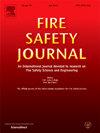夹芯板建筑外墙性能防火测试
IF 3.4
3区 工程技术
Q2 ENGINEERING, CIVIL
引用次数: 0
摘要
外墙是建筑系统的一部分,每天都有新的解决方案出现。这些系统通常使用新型材料建造,这些材料具有更强的耐热性,但防火性能较差。这种防火性能可以在大规模测试中进行评估,例如 BS 8414-1、LEPIR II 或 ISO-13785-1 标准中规定的测试,这些测试考虑的是火灾在建筑物内部爆发并通过窗户或通风口蔓延到外部的典型情况。然而,在某些情况下,这些系统可能会受到外部火灾的影响,例如森林大火、外墙旁边的货物燃烧,甚至是人为破坏,这些都是需要评估的。本文介绍了夹芯板建筑外墙行为评估的实验测试结果,夹芯板中含有四种不同的保温材料(矿棉、聚异氰尿酸盐、有机聚合物和聚氨酯)。测试根据 BS 8414-2 标准进行,考虑了常见的内部和新的外部火灾情况。外部着火情况是为了模拟建筑物外存放在墙壁旁边的货物或设备着火的情况。根据 BRE 135 附件 B 标准对墙体性能进行了检查。在这些测试中,记录了墙壁暴露面和未暴露面的温度以及墙壁表面的入射辐射热流量。外墙着火情况表明,外墙覆层比内墙着火更具侵蚀性,这表明必须对这种情况进行仔细调查,以便在未来的标准中对这种情况提出建议。本文章由计算机程序翻译,如有差异,请以英文原文为准。
Performance fire tests on building external walls made of sandwich panels
External walls are part of the construction system where new solutions appear every day. These systems are usually built with new materials that offer greater thermal resistance but with poor fire behaviour. This fire behaviour can be evaluated in large-scale tests, such as the ones prescribed at BS 8414-1, LEPIR II or ISO-13785-1 standards, that consider a typical scenario where the fire outbreaks inside the building and spreads to outside through a window or venting. However, there are situations in which these systems can be affected by external fires, such as forest fires, goods burning next to the external wall, or even sabotage, that are of interest to be evaluated. This paper presents the results of experimental tests for evaluating the behaviour of building external walls made of sandwich panels, of four different insulation materials in the core (mineral wool, polyisocyanurate - PIR, organic polymer and polyurethane - PUR). The tests were carried out according to BS 8414-2 standard, considering the common internal and a new external fire scenario. The external fire scenario was intended to simulate the case of goods or equipment stored next to the wall, outside the building, that catches fire. The walls' performance was checked according to BRE 135 Annex B criteria. In these tests were registered the temperatures in the exposed and unexposed face of the walls and the incident radiant heat flux in the wall surface. The external fire scenario showed that can be more aggressive to the external wall cladding than the internal fire, demonstrating that this condition must be carefully investigated to propose this situation in standards for the future.
求助全文
通过发布文献求助,成功后即可免费获取论文全文。
去求助
来源期刊

Fire Safety Journal
工程技术-材料科学:综合
CiteScore
5.70
自引率
9.70%
发文量
153
审稿时长
60 days
期刊介绍:
Fire Safety Journal is the leading publication dealing with all aspects of fire safety engineering. Its scope is purposefully wide, as it is deemed important to encourage papers from all sources within this multidisciplinary subject, thus providing a forum for its further development as a distinct engineering discipline. This is an essential step towards gaining a status equal to that enjoyed by the other engineering disciplines.
 求助内容:
求助内容: 应助结果提醒方式:
应助结果提醒方式:


